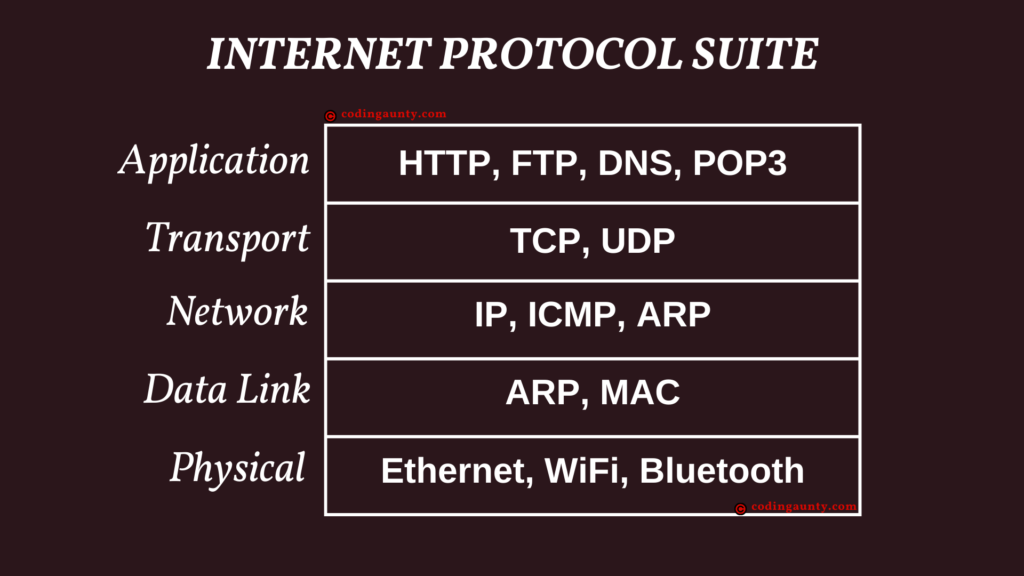The Internet Protocol Suite (also called TCP/IP model) is a practical framework for the communication protocols used on the Internet and other similar networks.
To understand it better, let’s take a real life analogy. Two people want to talk to one another: one person only speaks French and the other only speaks English. As the languages (or the rules of communication) are different, communication is going to be difficult.
The same is with internet devices. In order to communicate with one another, some ground rules are required. These ground rules which are common and agreed make up the TCP/IP model (also called the Internet Protocol Suite).
This set of protocols enables devices to exchange data and information over the internet, making it possible to access websites, send emails, stream videos, and much more.
It is named after two of the most important protocols in the model: the Transmission Control Protocol (TCP) and the Internet Protocol (IP).
Note that these are not the only protocols in the model, just the most important ones. TCP/IP or the Internet Protocol Suite consists of numerous protocols bundled at different layers.
The TCP/IP model consists of five layers, each with its own set of protocols and functions.
These five layers of the TCP/IP model are:
- Physical Layer: The Physical Layer is the first and lowest layer in the TCP/IP model. It deals with the physical transmission of data over the network. The protocols used at this layer include Ethernet, Wi-Fi, and Bluetooth.
- Data Link Layer: The second layer of the TCP/IP model is the Data Link Layer. This layer deals with the physical addressing of data packets and error detection and correction. The protocols used at this layer include ARP (Address Resolution Protocol) and MAC (Media Access Control).
- Network Layer: The third layer of the TCP/IP model is the Network Layer. This layer is responsible for routing data packets across the network. The protocols used at this layer include IP (Internet Protocol), ICMP (Internet Control Message Protocol), and ARP (Address Resolution Protocol).
- Transport Layer: The fourth layer of the TCP/IP model is the Transport Layer. This layer is responsible for end-to-end communication between devices. The protocols used at this layer include TCP (Transmission Control Protocol) and UDP (User Datagram Protocol).
- Application Layer: The fifth and highest layer of the TCP/IP model is the Application Layer. This layer is responsible for providing services to the end-users. The protocols used at this layer include HTTP (Hypertext Transfer Protocol), FTP (File Transfer Protocol), and SMTP (Simple Mail Transfer Protocol).

How is Data Transmitted?
Suppose there are two devices, in this case, computers. One computer is with Alice and another is with Bob. Alice wants to send a message to Bob.
This message can any type of digital media like a file, a voice converstaion, a video.
These messages are not sent as a single unit, instead they are broken into small data units. These data units are then transmitted through the network and restored through the receiver into the original message.
In TCP/IP protocol suite, TCP breaks messages into small data units called segments. these segments are then routed from the sender to the reciever by the IP protocol. The TCP module in the reciever then combines the segments to form the original message.
So in out Alice-Bob example:
- First, Alice’s message is broken into segments by TCP.
- Then, IP Protocol takes each segment from Alice to Bob.
- Lastly, TCP on Bobs side combines the segments to get the orginal message.
Now let’s see how each layer handles the message being sent.
The topmost layer of the TCP/IP protocol (The Internet Protocol Suite) is the application layer. This is where the message is generated.
So in the Alice-Bob example, the message is generated in the application layer on Alice’s(sender) side.
This message is then passed through the lower layers. At each layer the message is encapsulated. The message sent becomes larger and larger as it passes down the chain.

This message or data unit has different names in different layers.
- In the application layer, it is called an Application Message.
- In the transport layer, it is called a TCP Segment (in case of TCP protocol) or a UDP Datagram (in case of UDP protocol.
- In the network layer, it is called an IP Packet.
- In the data link layer, it is called an Ethernet Frame.

Once the data unit reaches the physical layer it is sent to the Receiver’s side of the model via a transmission medium.
So in this case, the data goes from the physical layer in Alice’s side to the physical layer in Bob’s side.
This data is then sent to the the data link layer on Bob’s side, which removes the headers added by the data link layer on Alice’s side. It then transmits the message upward to the network layer.
In this way, each subsequent layer removes it’s headers and passes the data upwards till it reaches the application layer.
To learn about each layer in more detail check these articles:
